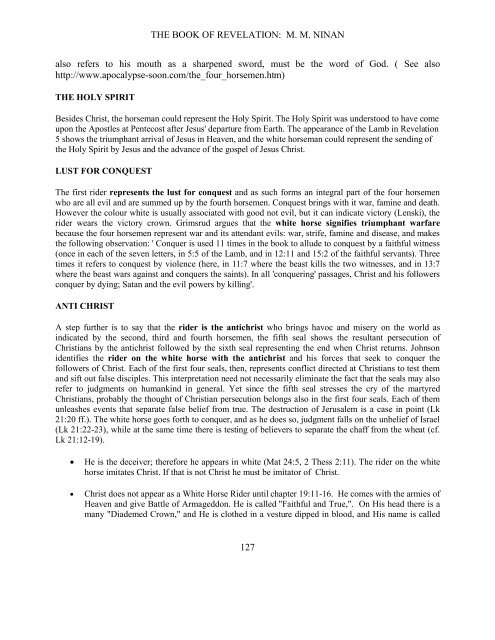Revelation
You also want an ePaper? Increase the reach of your titles
YUMPU automatically turns print PDFs into web optimized ePapers that Google loves.
THE BOOK OF REVELATION: M. M. NINAN<br />
also refers to his mouth as a sharpened sword, must be the word of God. ( See also<br />
http://www.apocalypse-soon.com/the_four_horsemen.htm)<br />
THE HOLY SPIRIT<br />
Besides Christ, the horseman could represent the Holy Spirit. The Holy Spirit was understood to have come<br />
upon the Apostles at Pentecost after Jesus' departure from Earth. The appearance of the Lamb in <strong>Revelation</strong><br />
5 shows the triumphant arrival of Jesus in Heaven, and the white horseman could represent the sending of<br />
the Holy Spirit by Jesus and the advance of the gospel of Jesus Christ.<br />
LUST FOR CONQUEST<br />
The first rider represents the lust for conquest and as such forms an integral part of the four horsemen<br />
who are all evil and are summed up by the fourth horsemen. Conquest brings with it war, famine and death.<br />
However the colour white is usually associated with good not evil, but it can indicate victory (Lenski), the<br />
rider wears the victory crown. Grimsrud argues that the white horse signifies triumphant warfare<br />
because the four horsemen represent war and its attendant evils: war, strife, famine and disease, and makes<br />
the following observation: ' Conquer is used 11 times in the book to allude to conquest by a faithful witness<br />
(once in each of the seven letters, in 5:5 of the Lamb, and in 12:11 and 15:2 of the faithful servants). Three<br />
times it refers to conquest by violence (here, in 11:7 where the beast kills the two witnesses, and in 13:7<br />
where the beast wars against and conquers the saints). In all 'conquering' passages, Christ and his followers<br />
conquer by dying; Satan and the evil powers by killing'.<br />
ANTI CHRIST<br />
A step further is to say that the rider is the antichrist who brings havoc and misery on the world as<br />
indicated by the second, third and fourth horsemen, the fifth seal shows the resultant persecution of<br />
Christians by the antichrist followed by the sixth seal representing the end when Christ returns. Johnson<br />
identifies the rider on the white horse with the antichrist and his forces that seek to conquer the<br />
followers of Christ. Each of the first four seals, then, represents conflict directed at Christians to test them<br />
and sift out false disciples. This interpretation need not necessarily eliminate the fact that the seals may also<br />
refer to judgments on humankind in general. Yet since the fifth seal stresses the cry of the martyred<br />
Christians, probably the thought of Christian persecution belongs also in the first four seals. Each of them<br />
unleashes events that separate false belief from true. The destruction of Jerusalem is a case in point (Lk<br />
21:20 ff.). The white horse goes forth to conquer, and as he does so, judgment falls on the unbelief of Israel<br />
(Lk 21:22-23), while at the same time there is testing of believers to separate the chaff from the wheat (cf.<br />
Lk 21:12-19).<br />
• He is the deceiver; therefore he appears in white (Mat 24:5, 2 Thess 2:11). The rider on the white<br />
horse imitates Christ. If that is not Christ he must be imitator of Christ.<br />
• Christ does not appear as a White Horse Rider until chapter 19:11-16. He comes with the armies of<br />
Heaven and give Battle of Armageddon. He is called "Faithful and True,". On His head there is a<br />
many "Diademed Crown," and He is clothed in a vesture dipped in blood, and His name is called<br />
127


















